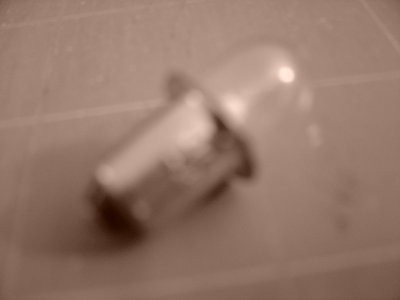Older Revision of Macro Photography with What You Got
Revision: 20071211_203948 | All Revisions
Macro Photography with What You Got
I've noticed a lot of blurry photos on the web, like the photo shown below. Most of these photos are of small objects, where the photographer is trying to capture details of the subject for communication on the Internat (think eBay auction and technical forum messages). Even though most readers can make out the subject in the blurry photo, blurry macro photos really puts a damper on communication.

The best thing to do, of course, is to spend a lot of money an expensive DSLR camera with a specialized macro lens. But that is simply not cost-effective for one-time macro shots. In this article, I will show you macro photography techniques to capturing everyday objects in a sharp presentable fashion, using equipment that you already have (whether it supports macro or not).
Step 1: Turn on Macro Mode (if your camera has it)
Most digital cameras have a macro mode. It is usually represented by the flower symbol (see photo below). If you haven't noticed it on your camera before, it might be time to read over the user's manual once again. Before you shoot any macro photo, always check to see if you camera has this macro functionality and turn it on! The macro mode allows your digital camera to focus much closer than you normally could.
Even if your digital camera doesn't support the macro mode, you can still capture small objects using the techniques presented in the rest of this article.
Step 2: Get as Close as You Can Without Blurring the Photo
Now you are ready to shoot the photograph. Move your digital camera toward the object. Use the auto-focus functionality to focus on the small object. Usually that's in the center of the image. If your camera can't achieve focus, that means your digital camera is too close to the object. Move the digital camera back and try again. Continue this process until you find that your digital camera can lock focus on the object. That is probably the closest your camera can be to the object for a sharp photo. When your camera's auto-focus can lock-on the object, your photo will be clear and sharp.
Try the widest zoom angle. Then try the telephoto zoom angle. Some digital cameras can focus really close to the object at the widest angle, while other digital cameras can focus really close at the telephoto angle. Most consumer digital cameras usually provides the closest focus and the largest object image at the wide end of the zoom. But you'll never really know unless you give it a try (or unless you read the camera specification very carefully).
Step 3: Shoot the Macro Photo
At the closest focus distance, snap the photo. Make sure that the auto-focus has locked-on to the object so that the photo is clear and sharp. Don't worry about extra space around the object that you are capturing; in the next step, we'll deal with the extra space. The important part is to capture a clear and sharp photo. The photo below is an example of a clear and sharp light bulb.
In the photo, the object doesn't fill the image frame and the photo has a lot of extra space around the object. It can hardly be considered as a macro shot. But in this step, the important part is that you've captured the object clearly.
Step 4: Crop the Photo
If you were able to fill the entire image frame with the object you are capturing, then you don't need to crop the photo at all. But if the image has a lot of extra space that distracts from the object you are trying to portray, you should crop the photo down to the size of the object as shown in the photo below.
The photo above is not a separately shot macro photograph. It is the exact same photo as the one with a lot of extra space. it's just cropped down tightly around the main object in question: the flashlight bulb.
With amount of megapixels a digital camera has today, you can still get a very presentable image (especially for web communication) even after cropping. In this article, I used a 5 megapixel consumer digital camera (Sony Cyber-shot DSC-P92 without any special accessories) to shoot the light bulb. After cropping it, the image still had almost 1 megapixel. I still had to scale it down to less than half a megapixel to present it to you in this article.
You can crop your macro photography with the photo software that came with your camera. Or you can download a free photo editing software like Gimp (see "Related Links" section below) for Windows, Linux, or Mac OS.
Related Links
- GIMP - The GNU Image Manipulation Program
- Macro photography
- Macro Photography for Beginners
467 Users Online
|
$10000-above $5000-$9999 $2000-$4999 $1000-$1999 $500-$999 $200-$499 $100-$199 $50-$99 $25-$49 $0-$24 Gift Certificate |
|




